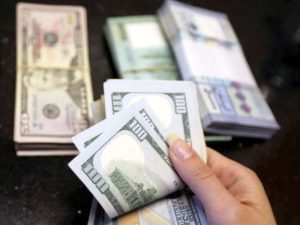US money vanishes from the market.
Traders query SBP’s methods for ensuring dollar availability.

Despite the rupee’s relative stability in the interbank market, there is a serious scarcity of US dollars on the foreign exchange market, which has caused traders to doubt the validity of the system in place for guaranteeing dollar supply. Former president of the Federation of Pakistan Chambers of Commerce and Industry Mian Anjum Nisar stated, “The downward trend of the dollar has shown to be useless as a majority of exchange companies and dealers have no dollars, and this scarcity has persisted for practically a week” (FPCCI).
He urged the central bank to exercise greater caution and stricter enforcement to guarantee the availability of US dollars on the open market. Ismail Suttar, President of the Employers Federation of Pakistan (EFP), stated, “Despite the rupee strengthening, there is a severe lack of US dollars available to money changers and dealers in Pakistan. Importers are irritated by the situation because they can’t buy dollars at better exchange rates. The government has recently discouraged imports, formally instructing Pakistani banks to avoid opening any Letters of Credit (LCs) and to prevent them from accepting any forward bookings on the US dollar, he said, attributing the scarcity to alternate channels of payment being utilized by importers.
In order to ensure that payments are made to their international partners, importers have begun adopting other methods, according to Sutter. He provided an illustration of this by demonstrating how importers purchased dollars through Afghan Transit and other unofficial routes in order to make payments because these dollar outflows are not shown in the current account deficit (CAD).
The previous FPCCI president emphasized the need for audacious actions, particularly given the unstable nature of the rupee’s stability against the dollar. As a result of concerns that the money is being trafficked to Afghanistan, he noted that “currently, limited transactions are being held against the daily normal transactions of up to $60 million dollars in the open market.
Smuggling is still prevalent despite the central bank’s restrictions, demonstrating that not all government agencies are working together, he said, pushing the government to review its trade and immigration policies with Afghanistan and Iran. Despite repeated assurances from Finance Minister Ishaq Dar that the rupee was undervalued and would soon return to its true value of Rs200 per dollar, the devaluation of the currency was principally caused by declining foreign reserves and uncertainty over commitments for inflows. Nisar went on to emphasise the CAD’s decrease for the third consecutive month in September.
It decreased to $0.3 billion, which is less than half the level from August. In Q1FY23, CAD decreased to $2.2 billion from $3.5 billion, which was recorded in Q1FY22, mostly due to a decrease in imports. For the South Asian economy, which is already dealing with declining foreign exchange reserves, this fall is encouraging, he continued. “The scarcity of dollars is a huge issue for importers; both vital commodities and non-essential items are at risk in case of no respite,” said Ahsan Mehanti, Chief Operating Officer (CEO) of Arif Habib Commodities. The State Bank of Pakistan (SBP) was forced by the International Monetary Fund (IMF) program to buy dollars on the open market for imports, which contributed to the shortfall.
Banks have been helpful by refraining from speculation, but for stability, he said, the formal channels should also assist the informal channels. The central bank should be fully prepared to intervene and watch the movements more diligently, being ahead of the curve as they have more knowledge than an ordinary market player, according to Nisar, who insisted that having a clear policy to reduce volatility in the currency market is essential. Additionally, the government must loosen its regulations for exchange organisations because their strict procedural requirements were deterring buyers from approaching the open market. Pakistan has seen repeated exchange rate crises this year amid falling foreign exchange reserves, and the government has vowed to crack down on speculators.
The planned move coincides with the rupee’s erratic fluctuations, which saw it hit record lows in the interbank market and experience its worst monthly performance in more than 50 years in July. Tahir Abbas, Head of Research at Arif Habib Limited (AHL), stated that “the sentiment and dollar supply are expected to improve going forward with the expected inflows from the World Bank and other lenders,” adding that “the IMF review is also scheduled next month which will unlock a $1 billion tranche.” In addition, there are many rumors surrounding Prime Minister Shehbaz Sharif’s upcoming trip to China, which many people are hoping will provide Pakistan with some relief from its need for foreign money, according to Abbas.
The rupee appreciated by about 10% in less than three weeks as a result of Ishaq Dar’s appointment as finance minister, the former FPCCI president said, but it also led authorities to suspect manipulation by banks and exchange companies. The SBP announced that it would wrap up its probe into the purported manipulation of foreign exchange operations in the nation by commercial banks in early October.










































